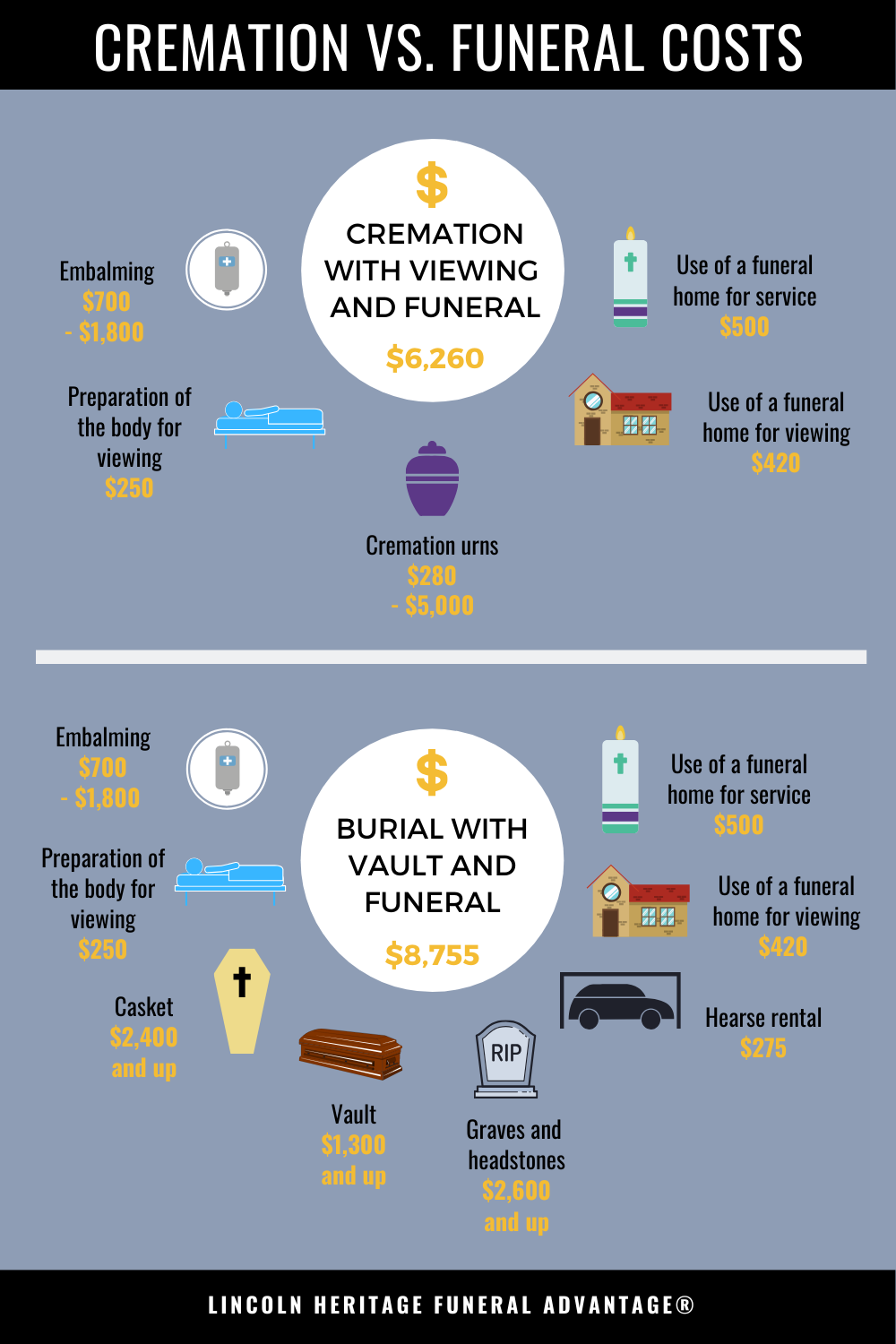Cremation vs Burial – Which Is Best for You?

Many people think of cremation as the cheaper option, but the cost of cremation vs burial can be very close depending on the services and products you buy. When you choose cremation, you’re paying not only for the cremation itself but also your choice of urn and (in some cases) a vault or crypt. When you choose burial, you’re paying for the embalming, your choice of casket, and the actual opening and closing of the grave. In both cases, you’re likely paying for the transportation of the deceased as well.
In addition to these costs, you could be responsible for decisions about viewings, whether to have a memorial or funeral service, arranging family transportation, and gathering all of the official paperwork. Each of these comes with additional costs – some small, some very large.
The National Funeral Directors Association’s (NFDA) most recent survey of costs for funerals and cremations estimates the median cost of a funeral with burial to be around $9,420 and the median cost of a funeral with viewing and cremation to be about $6,970. In both cases, however, certain choices will increase the expenses.
Understanding the basics of each service ahead of time can help you make an informed decision now, preventing your loved ones from experiencing unnecessary stress and confusion when you pass. Here’s a breakdown of the process and cost of cremation vs burial, as well as a general idea of how high the prices of certain choices can be.
Table of Contents
Cremation vs Burial: A Quick Comparison
The choice between cremation vs burial is a deeply personal one. When people work on their prepaid funeral plans and think about what will happen to their body after they pass, they often have many questions about the differences in these processes.
Take a look at the following information to see what this entails.
The Cremation Process
Cremation laws vary from state to state; however, there are some regulations concerning preparation and transportation that are consistent across the country. Here’s what you need to know before, during, and after the cremation process.
Before cremation
Depending on the state, funeral directors must wait for a time of up to 48 hours between the death and the cremation is performed. Officials use this time to complete the required authorization forms and ensure that the necessary permits are completed and collected.
Before the cremation begins, family members can say goodbye, perform rites of passage, or conduct a funeral service. If a funeral or visitation service occurs, the family can collect any personal possessions or valuable materials – such as jewelry or other personal objects – after the service.
During cremation
All cremations are performed individually. The staff begins by placing the casket or container in the cremation chamber.
This chamber can reach temperatures between 1,400 and 1,800 degrees Fahrenheit, ensuring all remains are completely processed. The process typically takes 1 - 3 hours, depending on the size and weight of the body.
A cooling period follows the cremation to allow the remains to cool enough so staff can handle them. The remains will weigh between 3-9 pounds and are usually white.
After cremation
Unless specified otherwise, the urn or container chosen to house the remains is returned to the family or the designated cemetery or funeral home. There are several options when deciding the final resting place of the remains. These include:
- Placing the urn in an indoor or outdoor mausoleum
- Burying the urn in a family burial plot or cemetery urn garden
- Scattering the remains according to the deceased’s wishes
- Keeping the urn in the home of a loved one
Cremation Pros
- It’s more affordable.
- Loved ones can keep your remains with them.
- There are no time restraints.
- A cremation can take place in any location.
Cremation Cons
- Some family members may not be comfortable with the procedure.
- Not every locale offers cremation.
The Burial Process
Regardless of the service selected, the first step of the burial process is bathing and disinfecting the body. Doing this helps protect the funeral staff, visiting friends, and family, and it provides a measure of dignity and respect for the deceased.
Before service
The family or friends in charge of the funeral arrangements determine the next steps. The body can be embalmed for a traditional funeral service or placed in refrigeration if being transported to another state.
If the decedent died while out of town or the family chooses a burial in a different location, arrangements must be made to transport the body to its final resting place. Typically, a funeral provider will make transportation arrangements because of their understanding of the specific requirements for transporting bodies.
Before burial
If embalming is required or chosen by the family, a licensed embalmer is used to perform the service. In most cases, the funeral director is the licensed embalmer, which makes organizing these arrangements easier.
Embalming occurs when the staff replaces the body’s blood with chemical preservatives through the circulatory system. There is no state law requiring embalming, although some states may require embalming or refrigeration if the burial doesn’t take place within a certain period.
Refrigeration is often an acceptable alternative to embalming. Some services – such as immediate burial – don’t require embalming.
If a viewing is part of the service, the family will need to select clothing and mementos (such as jewelry and glasses) for the decedent. Anything worn by the decedent during the viewing can be returned to the family before the burial takes place (or left with the deceased). Cosmetics are applied, and the hair is styled according to the family’s wishes.
After service
What happens next depends on the type of funeral performed. Traditional funerals typically include transporting the body to a cemetery or other gravesite. In some cases, an official will perform a graveside service.
Burial Pros
- Loved ones have a place to visit your remains.
- It’s more familiar and more people are comfortable with it.
- Family can make it personal by choosing the casket, headstone, and the location of the site.
Burial Cons
- Burials are more expensive.
- Cemeteries have rules, and they can limit your choices.
Statistics & Which Is More Popular?
Cremation has become an increasingly popular choice for many Americans. The rate of cremation surpassed that of burial, according to the National Funeral Directors Association (NFDA). And projections show that, in 2040, the rate of cremations will almost reach 80 percent.

Cost of Cremation vs Burial
When choosing between cremation vs burial, you will have many options, whether you are pre-planning your funeral or helping your parents plan theirs, the cost of cremation vs burial is a motivating factor for many people. Most expenses associated with traditional burials are higher than the costs of cremations, and it’s not uncommon for people to overspend when planning a funeral.
The best way to keep costs in check is to research your options ahead of time. Knowing what’s available in your area can help you avoid overspending on funeral costs.
The National Funeral Directors Association cost comparisons for 2021, the latest available data, indicated that the national averages for adults were $6,970 for cremation with a viewing and funeral and $9,420 for a burial with a vault and funeral.
When it comes to the cost of cremation vs burial, cremations are typically a fraction of the price associated with a traditional funeral or burial because fewer services are involved. As mentioned, the average cremation cost varies from state to state, but the type of cremation performed (direct cremation, cremation with a viewing, cremation with a memorial, etc.) can also affect the cost. As a result, services can range from $1,000 - $3,000 on the low end of the spectrum but can cost as much as $6,000 - $8,000 depending on what options you select.
| CREMATION COSTS Embalming and other preparation of the body: Embalming is not mandatory for cremation, especially if the family wishes to have a direct cremation, which is cremation shortly after death. But most funeral homes require it if the family wishes to have a viewing. The median cost for embalming is about $775. Other preparation of the body includes any cosmetic work and dressing done to prepare the body for viewing and can cost about $275. There is an additional fee of about $450 if using the funeral home for the viewing, plus $515 for the funeral service itself. | BURIAL COSTS Embalming and other preparation of the body: Embalming is not required if the family wishes to have a direct burial, which means burial shortly after death, independent of a funeral or graveside service. But if you want a viewing, you will have to pay for embalming – at a median cost of about $775. The cosmetic work and dressing done to prepare the body for viewing is the “other preparation of the body,” and costs about $275. There is an additional fee of about $450 if the funeral home is used for the viewing, plus $515 if you use it for the funeral service. |
|---|---|
| Casket: $2,500+ A casket is needed for cremation when there is a viewing or funeral service. The NFDA estimates the median cost at about $2,400, though some funeral homes have “rental” caskets used during a funeral service before transferring the body for cremation.
| Casket, vault, and hearse: $3,900+ The NFDA gives the median cost of a metal casket at about $2,500 and the cost of a vault – which many cemeteries require to protect the casket from the weight of the dirt above it – at about $1,575. Costs can vary wildly. Caskets can be made of steel, solid hardwood, bronze or copper, and can even be customized. The National Caregivers Library says the most expensive caskets go as high as $65,000, and the most expensive vaults add as much as $10,000 to that price. The average cost of a hearse to transport the body to the cemetery is $350, and that typically includes the services of the driver. |
| Cremation urns: $280 - $5,000+ If a family plans to scatter the ashes of their loved one, they may need only a basic urn; the median price is $295. That cost is generally for an urn made of ceramic, wood, or metals such as pewter or stainless steel. If a family provides its own cremation urn, the price can run anywhere from $50 to $5,000 or more. The most expensive urns are constructed with precious metals or marble and may have one-of-a-kind engravings. They can also include precious stones. “Keepsake urns,” which are small urns meant to keep only a portion of the ashes, can cost between $10-$250 depending on materials used. Graves and headstones: $2,600+ The National Network of Cemeteries estimates the average cost of gravesites by state with most in the $1,100 - $2,000 range, except for California, which is closer to $4,000. (These prices are in addition to the funeral costs.) There may be different price levels within individual cemeteries themselves as well, depending on the location and the type of plot that you buy. Grave markers can be as simple as a granite plaque placed flush to the ground or as elaborate as a customized stone marker that sits upright. The average cost is about $1,500 to $2,000, according to the International Southern Cemetery Gravestones Association, but can run upwards of $10,000 depending on size, shape, and material chosen. |
Average Funeral Costs
Since the 1980s, the average funeral cost has continued to rise. Today, you can expect to pay between $7,000 and $12,000 for a funeral. These prices include the viewing and burial as well as basic transportation fees, a casket, embalming and other body preparation, and the funeral home’s service fees. The prices do not include extras such as flowers, the cemetery plot, or a monument or marker.
Your final cost will depend on your decision between cremation vs burial. Funeral expenses vary from state to state and can be affected by the services selected. In most cases, a funeral costs about $9,000, but expenses can quickly escalate from there.
In both cremation and burial, the NFDA estimates a $2,300 “non-declinable basic services fee,” which goes to pay the funeral home’s overhead, including the salaries of its employees and the maintenance and upkeep of the facilities.
These things are typically included in the service fee:
-
- Consultations with the family
- Coordination of plans between facilities (such as the crematory, church, funeral home, and cemetery)
- Taking care of the body of the person who has died
- Ensuring that professionals handle all official documents and legal papers properly
The things that the service fee typically doesn’t include are:
-
- Fee to transport the person who died to the funeral home (estimated around $350)
- The “basic memorial printed package,” which includes such things as a memorial register book, thank-you notes, and prayer cards (estimated around $185)
How Final Expense Insurance Can Help
It’s easy to see how quickly funeral costs can add up. Even considering national median prices, they cost thousands of dollars – which can be an unexpected burden for a family that has just lost a loved one.
An increasing number of people are using final expense insurance – also called “burial insurance” or “funeral insurance” – so this doesn’t happen. It’s specifically designed to help families cover any expenses – such as medical bills or funeral costs – left behind after a loved one dies.
For more information about final expense insurance and how it can help protect families from rising funeral costs, read Why Final Expense Insurance?
Environmental Impact
There is no consensus on whether cremation or burial is a greener choice. Proponents of cremation say that the materials used in most caskets aren’t biodegradable, plus embalming fluid is harsh on the environment. On the other hand, proponents of burials say that cremating a body causes harm to the environment by releasing pollutants into the air.
Religious Considerations
The view on cremation varies among the different religions. For instance, until the 1960s, the Catholic Church didn’t allow it but has since lifted the ban on cremation as long as they bury the remains. And the more fundamental Christian denominations do not allow cremation. But the Lutheran and Methodist Seventh Day Adventist churches do.
And while cremation has been forbidden in the Jewish faith, it is now accepted by some. The Muslim faith forbids cremation, but some eastern religions such as Buddhism and Hinduism require it.
Green Burials & Other Alternatives
As an alternative to traditional burials, some people are turning to green burials and other alternatives. Green burial uses biodegradable caskets such as those made from wood or cardboard. And they don’t use embalming fluid to preserve the body.
Other people donate their bodies to science. Doing so allows researchers to advance cures, and they return the cremated remains to the family in the end.
FAQs
What religions do not believe in cremation?
The Muslim religion forbids cremation and requires a burial. And some fundamental Christian religions, such as those found in the Middle East, do not allow cremation.
Do you have clothes on when you're cremated?
You can choose whether or not to wear clothes if you’re cremated. If you do, the clothes will be burned and turned to ashes. But for some, the clothes provide a level of privacy and discretion.
What does the Bible say about cremation vs burial?
The Bible doesn’t provide any clear direction on whether a Christian should be cremated or buried. There are instances of both burials and believers being burned in the Bible.
Cremation vs Burial: Choosing Your Final Arrangements
No matter which final arrangement you choose, it’s important to discuss the various options with those who will be in charge of implementing your final wishes. Ninety-two percent of people believe discussing these matters with their loved ones is important, yet only 32 percent of people do it according to The Conversation Project.
By discussing your wishes in advance, you can spare your loved ones from having to make difficult decisions during a highly emotional time, including whether you’d choose cremation vs burial. And by planning in advance, you can help save them hundreds – even thousands – of dollars on final arrangements.
To help prevent overspending, it’s important to compare several service providers ahead of time. Request multiple quotes, and talk through the options with your family members. When dealing with multiple providers, it’s important to know your rights when it comes to the cost of cremation vs burial. Document your decisions, and keep them in a safe place where family members can easily access them.


